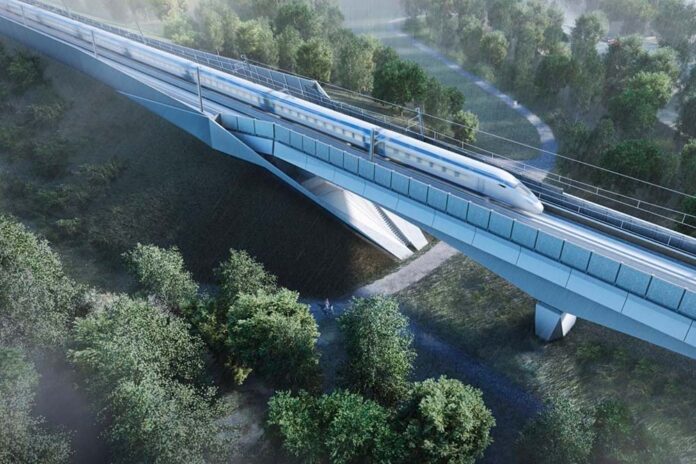HS2 says it is on target to cut the amount of embedded carbon on the UK’s longest railway bridge by at least 28.4%.
The team working on the Colne Valley Viaduct has cut carbon emissions caused by the project by 63,300 tonnes CO2e – the equivalent of 234,500 flights from London to Edinburgh.
HS2 says concrete and steel production are major sources of CO2 emissions, so the solution was to narrow the width of the viaduct. The result was a significant reduction in carbon, and less disruption for local residents by reducing the number of HGVs on local roads.
The Colne Valley Viaduct will stretch for 3.4km across a series of lakes on the outskirts of London. Its design inspired by a stone skipping water, it will be one of the most high-profile structures on the new HS2 high speed rail link under construction between London, the West Midlands and Crewe.
HS2 Ltd’s main works contractor Align JV – a team made up of Bouygues Travaux Publics, Sir Robert McAlpine, and VolkerFitzpatrick – worked for four years on the design with architects Grimshaw and design partners Jacobs and Ingerop-Rendel.
Billy Ahluwalia, HS2 Ltd Senior Project Manager, said: “By providing a cleaner, greener way to travel, HS2 will help cut the number of cars and lorries on our roads, cut demand for domestic flights, and help the fight against climate change.
“But we’re also serious about reducing the amount of carbon we use during construction, and the Colne Valley Viaduct is a great example of how we’re using the latest engineering techniques to do just that. Concrete is one of our industries’ biggest sources of embedded carbon – and this design will help us cut our carbon footprint while delivering a lighter, stronger and more elegant structure.”
Alan Price, Align Design Director said:“In designing the viaduct we have had to address the challenges of not only building a structure capable of handling the huge forces that will be exerted on it from high speed trains operating in both directions, but also to meet the demands of local stakeholders, creating a design that not only makes a positive statement, demonstrating world class engineering, but also really works within the environment in which it is placed.
“Working through the design process and using the original specimen design as a starting point, we have been able to deliver not only an iconic design but also a significant reduction in CO2 required to build the viaduct. This is not only a significant achievement for all those involved, but also for the environment.”
Construction began earlier this year, with the first of 292 concrete piles sunk into the ground to form the foundations for the viaduct.
On top of each group of piles – some of which will go up to 55m into the ground – a concrete pile cap will support each of the 56 piers which will in turn support the full weight of the bridge structure above. Instead of hammering the piles into the ground, holes are being bored before being backfilled to create the pile.
Set low into the landscape, the piers will support a series of spans, some as long as 80m, which will carry the railway around 10m above the surface of the lakes, River Colne and Grand Union Canal.
The main deck of the viaduct will be built in sections at a temporary factory nearby before being assembled from north to south starting next year.



































 0113 2082620
0113 2082620 info@railbusinessdaily.com
info@railbusinessdaily.com 15 Mariner Court, Wakefield WF4 3FL
15 Mariner Court, Wakefield WF4 3FL

